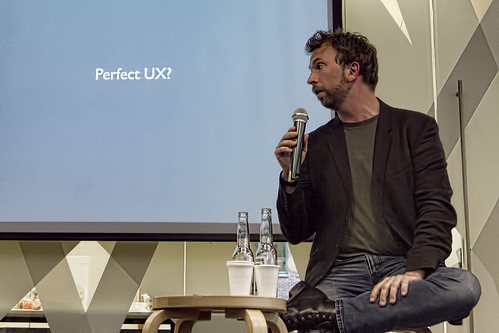Practice makes perfect UX at the UK UPA

I like UK UPA events. There’s something very reassuring about carrots in a bowl and speakers worth listening to. Last Thursday’s ‘Profiling the Perfect UX Practitioner’ was a particularly good event, pulling together a great list of UX practitioners to talk about UX practitioners to a room full of UX practitioners. While that sounds like it could be the point where we actually end up eating each other, it was actually the point at which we start questioning each other, which is always healthy.
There was no danger of it being a dull affair. Most of us have seen Andy Budd or Jason Mesut speak before and know that even though painful honesty borders on willful disruption it’s a dramatic tension that makes it not a little bit exciting. Put these menaces together with ‘not intentionally provided as a counterpoint but actually it works quite well that way’ Stavros Garzonis and Aline Baeck and you have a pretty good spread of disciplines, experiences and specialities that might, arguably, add up to the perfect UX practitioner, thereby rendering the whole evening redundant.
But that’s the thing. There’s not really any such thing as the perfect UX practitioner and we weren’t really there to try and determine what that is, any more than we were there to determine who has the brightest trousers, even though, as it happens, that was a really easy one to call. To summarise: it depends. With knobs on.
If there was a recurrent theme regarding the problem with defining pathways to becoming a better, more well-rounded UX practitioner, is was dichotomies. That is to say, perhaps it is the current open migration paths into UX from, say, engineering, development, psychology, for example, that are essentially dichotometrically opposed to the establishment of practitioner pathways since you have to already be pre-disposed within those disparate paradigms to an affinity with the values of user-centrednessness. Or something. I may have lost track there for a moment when I realised dichotmetrically opposed reminded me of thumbs. Anyway, there were dichotomies.
Also worthy of circular arguments was the notion of certification for UX professionals so that we all know who’s good at it. Notwithstanding the fact that none of can agree on what it is. Admirably, the German UPA chapter are looking seriously at certification, which, I’m sure, will be looked at closely to see how it might affect perception of value, ability or perfection in the long term. I asked Oliver what he thought of it. He kind of shrugged.
And it wouldn’t be a discussion about our ability to demonstrate capability without touching on, and then deep diving into, and ultimately wrestling naked in front of the fire about UX practitioner portfolios. Porfolios are good. If you think they’re good. Even though your good might not be my good. But let’s all agree they have value. In the way I value straight lines, but someone else values sketchy ones. You see. It depends. But let’s also agree that if you want an opinion on the basic thresholds of portfolio benchmarking and what, from sheer volume, might be considered the relative merits of showing deliverables vs. telling stories and demonstrating thinking, reacting, shifting, agiling, then Jason is the man to tell you to leave the wireframes at home.
Ultimately, the sum of the parts of a strong team are often what makes the whole of a perfect practioner and it’s being part of those teams that will most likely incubate the hard and soft skills required to effectively practice in the UX profession. There might be, and probably are, practitioners out there that come close to having it all, but you won’t be that person with 2 years in the industry and an impressive job title. That’s not to say that the perfect practitioner necessarily comes from the small pool of 10+ year UX veterans who like to remind you that they actually did the original user research on punched cards for jacquard looms or something, but, to be honest, longevity in the field simply affords you the benefit of experience. It’s hard to argue against it.
I enjoyed all the panellists. I enjoyed all the attendees. I even enjoyed sitting on the floor for most of the evening so I could take photos of Andy’s boots. My favourite moment? Grinning inanely while Andy ranted animatedly about how terrible the state of somethingorother was and how you should just forget about doing it when patently plenty of people in the audience were already doing it. My least favourite moment? Having to run off and leave everybody having a nice chat over fava beans and a nice chianti, because I had to rush to get a train to Norwich because we don’t all live in London you know.
Looking forward to the next one.

